软件产品评审表
- 格式:doc
- 大小:59.00 KB
- 文档页数:4
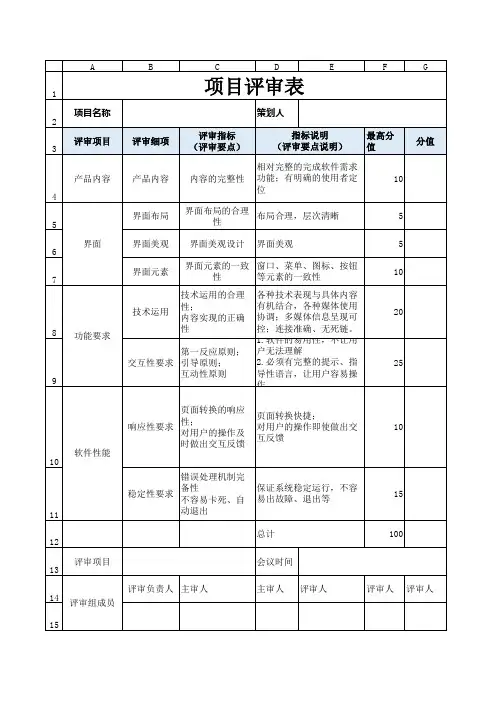
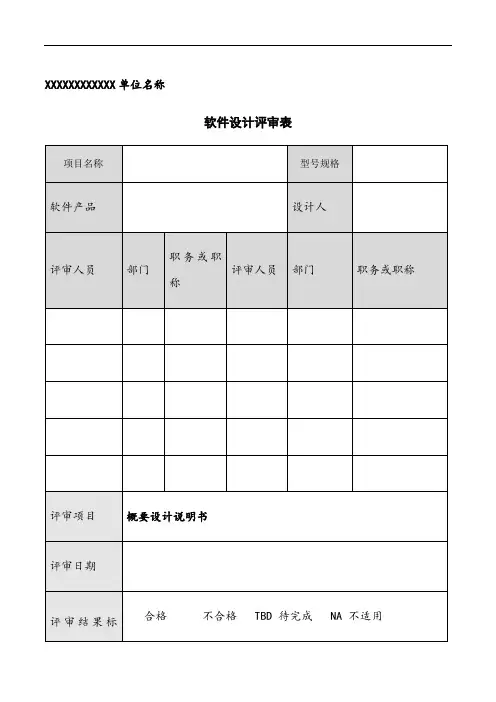
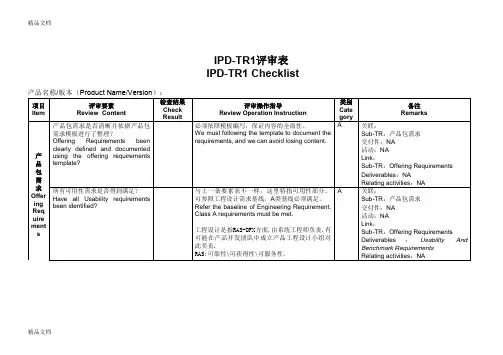
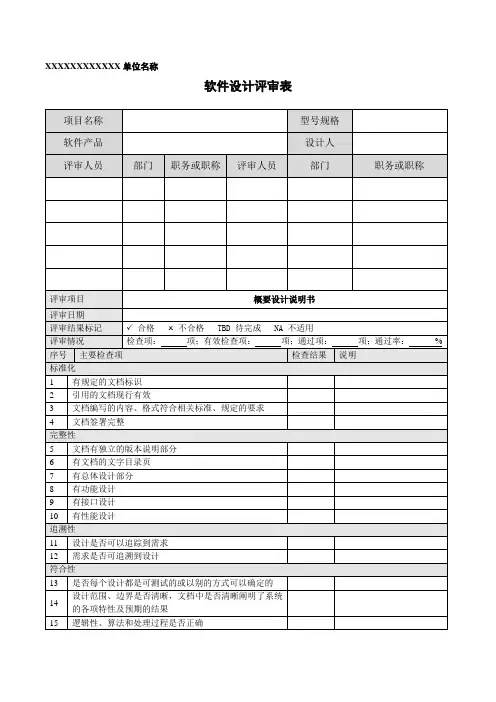
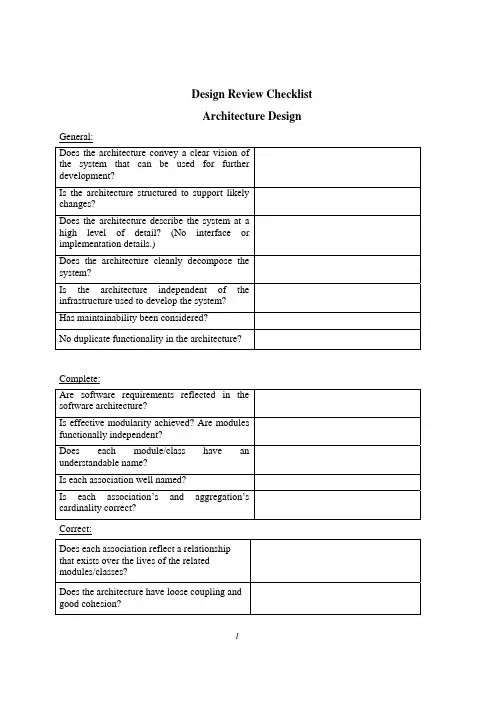
Design Review ChecklistArchitecture DesignGeneral:Does the architecture convey a clear vision ofthe system that can be used for furtherdevelopment?Is the architecture structured to support likelychanges?Does the architecture describe the system at ahigh level of detail? (No interface orimplementation details.)Does the architecture cleanly decompose thesystem?Is the architecture independent of theinfrastructure used to develop the system?Has maintainability been considered?No duplicate functionality in the architecture?Complete:Are software requirements reflected in thesoftware architecture?Is effective modularity achieved? Are modulesfunctionally independent?Does each module/class have anunderstandable name?Is each association well named?Is each association’s and aggregation’scardinality correct?Correct:Does each association reflect a relationshipthat exists over the lives of the relatedmodules/classes?Does the architecture have loose coupling andgood cohesion?1Detailed DesignGeneral:Does the design support moving to the next phase ofdevelopment?Does design contain proper level of detail?Does the design have conceptual integrity? (Qualitywhere the individual pieces all contribute to making alarger whole. Design consistency.)Will the design be easy to port to anotherenvironment?Have reusable components been identified?Is effective modularity achieved? Are modulesfunctionally independent?Complete:Is the class design consistent with architecturaldesign? (i.e., each class traceable to architecturalcomponent and no classes span architecturalcomponents)Does each class have an understandable name?Does each class define attributes, methods,relationships, and cardinality?Is each association well named?Is each association’s and aggregation’s cardinalitycorrect?2Correct:Does each class have a clearly defined purpose? Caneach class be described in a single sentence?Is a consistent naming scheme used for all classes?Are all attributes private?Are all method signatures specified including returntypes and parameters?Do all subclasses implement the "is-a-kind-of"relationship properly?Is there no duplicate functionality between classes inthe design?In inheritance structures, are all attributes and methodspushed as high in the inheritance structure as isproper?Are all polymorphic methods within related subclassesidentically named?Does each association reflect a relationship that existsover the lives of the related objects?Has error handling been specified?Is design detail amenable to implementation language?No hidden implementation details shown?Does design display high cohesion and low coupling?Consistent:Are each 0..* and 1..* relationships implemented withcontainers/collectors?Are each association’s cardinalities consistent(instantaneous vs. over-time)?Are the views provided by different modelingnotations consistent?Is a consistent naming convention used and followed?3。
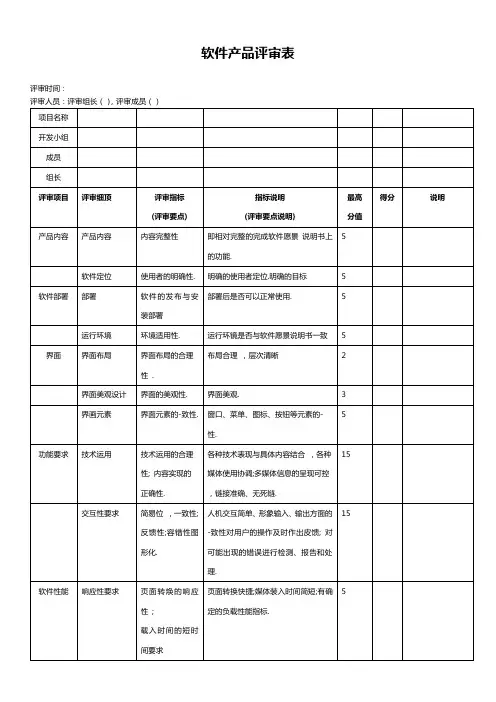
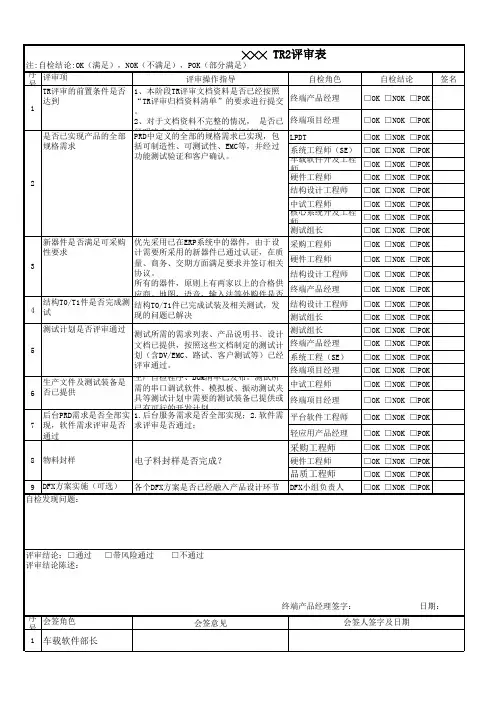
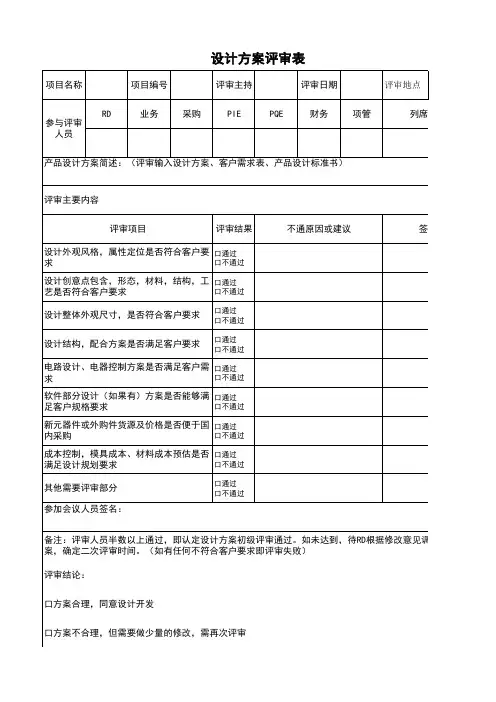
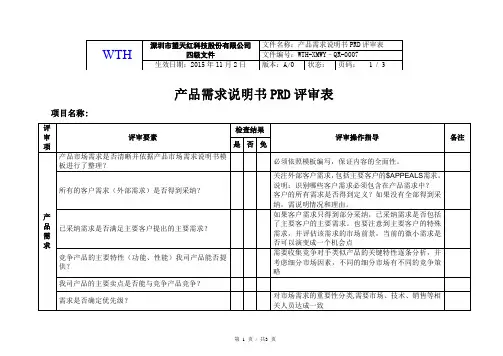

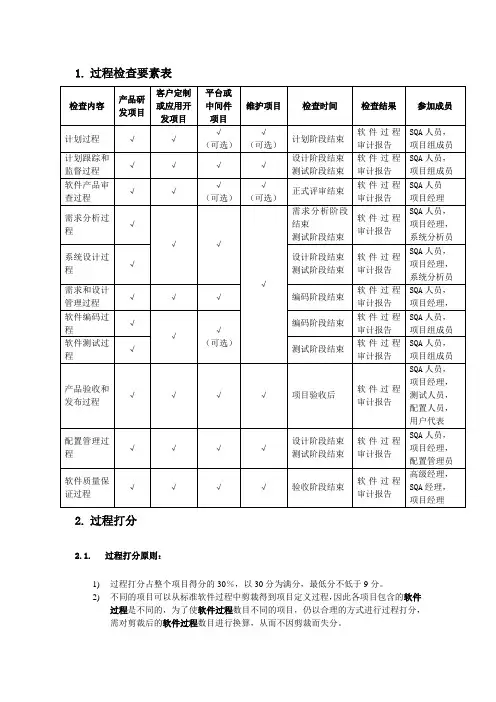
1.过程检查要素表2.过程打分2.1.过程打分原则:1)过程打分占整个项目得分的30%,以30分为满分,最低分不低于9分。
2)不同的项目可以从标准软件过程中剪裁得到项目定义过程,因此各项目包含的软件过程是不同的,为了使软件过程数目不同的项目,仍以合理的方式进行过程打分,需对剪裁后的软件过程数目进行换算,从而不因剪裁而失分。
3)SQA人员对经剪裁的软件过程的检查内容和实施情况进行剪裁。
4)项目级的软件过程剪裁必须得到高级经理,质量管理部经理和项目SQA人员的检查和认可;检查内容和实施情况剪裁必须得到项目经理和受审计人员的认可。
5)软件过程检查打分的依据是“过程检查表”。
2.2.打分步骤:1)依据标准过程定义项目过程,得出项目过程数N。
2)每个项目过程的得分M=30 / N。
3)采用“过程检查表”,对各个过程进行检查和打分。
4)定义“过程检查表”中的实际检查内容项个数为X,每项标准得分10分,因此每个“过程检查表”的最高得分A = 10X。
5)实际检查时,对“实施情况”一栏中每个条款进行打勾“”,因此实际每项得分Bj=(打勾条款数/ 该项实际检查总条款数)×10。
6)每个过程的实际得分Bi=∑1x Bj。
7)每个过程的换算得分B=Bi /A ×M。
8)若某个过程发生多次z,则该过程得分B=(∑1zB)/z 。
9)项目的过程得分C=∑1NB 。
10)为确保项目组的基本得分不低于9分,因此各过程打分不得低于9/N分,低于此分,以9/N分计算。
2.3.例子:某项目计划进行5个阶段的审计:计划过程,需求过程,设计过程,测试过程,计划跟踪和监督过程,其中计划跟踪和监督过程执行两次,其他各一次则每阶段得分M=30/5=6;第一次计划跟踪和监督过程检查项共15项,实际由于变更未发生检查了13项, 标准分为A=13×10=130,实际检查得分Bi=123则该阶段得分B1=123/130 * 6=第二次计划跟踪和监督过程,实际检查了15项,标准分为15×10=150;实际检查得分140。
文件编号供应商名称:(填写供应商公司名称)评分标准优(90-100);良(80-89)中(70-79);合格(60-69)不合格(50-59)(信息化产品包括但不限于:IT基础设施、基础软件、应用软件、信息安全等;信创产品优先)②行业认可能力获厂家授权产品数量≥10(优)获厂家授权产品数量≥7(良)获厂家授权产品数量≥4(中)获厂家授权产品数量≥2(合格)要求:换算为授权产品数量评比厂家1个产品=4个产品授权供应商1个授权=1个产品授权获得产品生产厂家评选优质代理商,且合作服务超过10年的;(优)获得产品生产厂家评选优质代理商,且合作服务超过7年的;(良)获得产品生产厂家评选优质代理商,且合作服务超过4年的;(中)获得产品生产厂家评选优质代理商,且合作服务超过2年的;(合格)供应商审查评审表(此评分项①公司规模公司注册资金(M):M≥5000万;(优)5000万>M≥3000万;(良)3000万>M≥1000万;(中)500万及以上的。
(合格)提供进入全国500强企业、欧美企业、上市公司、本地国企供应商库且为头部或长期合作供应商的。
成为10家企业(上述标准)优质供应商的;(优)成为7家企业(上述标准)优质供应商的;(良)成为4家企业(上述标准)优质供应商的;(中)成为2家企业(上述标准)优质供应商的。
(合格)获得厂家对供应商做以下授权的:一级代理商;(优)二级代理商;(良)三级代理商;(中)四级代理商。
(合格)评分人签字(评分人签字)注意:1、每个评分细项的4档分别对应“优”、“良”、“中”、“合格”,如低于第四档,则为“不合格”。
2、综合得分75分及以上且所有评分项平均分都在60分及以上的审定结果为“建议入库”,否则为“不建议入库”结论:建议入库 不建议入库(综合得分75分以上的建议入库③合作实力审查日期:(填写审查时间)取平均分值取平均分值评审表(供货类)(此处设计文件编号)打分根据数额选择(优、良、中、合格)打分,分值在评分标准中取值根据数量选择(优、良、中、合格)打分,分值在评分标准中取值根据年限时间选择(优、良、中、合格)打分,分值在评分标准中取值平均分取平均分值综合得分(均分)建议入库(综合得分75分以上的建议入库)根据数量选择(优、良、中、合格)打分,分值在评分标准中取值根据等级选择(优、良、中、合格)打分,分值在评分标准中取值日期(填写日期)。